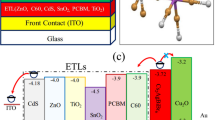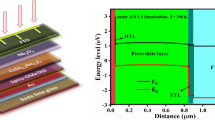Abstract
Theoretical study of methyl-ammonium bismuth halide perovskite solar cells, (CH3NH3)3Bi2I9, was carried out using a one-dimensional Solar Cell Capacitance Simulator (SCAPS-1D) software. The performance of the tested device architectures largely depends on the thickness of the absorbing layer, with the combination of electron transport, and hole transport layers. Thus, the bismuth perovskite absorber layer was optimized by varying the thickness and also, the thicknesses of the different charge-transport materials such as Spiro-OmeTAD, copper(I) oxide (Cu2O), and copper(I) iodide (CuI) as hole transport layer (HTL), and phenyl-C61-butyric acid methyl ester (PCBM), poly(3-hexylthiophene-2,5-diyl) (P3HT), zinc oxide, and titanium dioxide as electron transport layer (ETL). The best performance in terms of the power conversion efficiency (PCE) was recorded for the device with Cu2O as the HTL and ZnO as the ETL with the absorber layer thickness of 200 nm. The working temperature of the device was varied from 295 to 320 K and the effects of temperature on various device architectures were investigated. Results obtained indication that the efficiency of the bismuth perovskite solar cells can be improved by optimizing the thickness of the absorber layer and utilizing an appropriate combination of HTLs and ETLs.



Similar content being viewed by others
REFERENCES
C. Zuo, H. J. Bolink, H. Han, J. Huang, and D. Cahen, Adv. Sci. 3, 1500324 (2016).
A. Kulkarni, T. Singh, M. Ikegami, and T. Miyasaka, RSC Adv. 7, 9456 (2017).
N. Kour and R. Mehra, Int. Res. J. Eng. Technol. 4, 1284 (2017).
P. C. Harikesh, H. K. Mulmudi, B. Ghosh, T. W. Goh, Y. T. Teng, K. Thirumal, M. Lockrey, K. Weber, T. M. Koh, S. Li, S. Mhaisalkar, and N. Mathews, Chem. Mater. 28, 7496 (2016).
R. L. Z. Hoye, R. E. Brandt, A. Osherov, V. Stevanovic, S. D. Stranks, M. W. B. Wilson, H. Kim, A. J. Akey, J. D. Perkins, R. C. Kurchin, J. R. Poindexter, E. N. Wang, M. G. Bawendi, V. Bulovic, and T. Buonassisi, Chem. Eur. J. 22, 2605 (2016).
N. Park, Mater. Today 18, 65 (2015).
N. K. Noel, S. D. Stranks, A. Abate, C. Wehrenfennig, S. Guarnera, A.-A. Haghighirad, A. Sadhanala, G. E. Eperon, S. K. Pathak, M. B. Johnston, A. Petrozza, L. M. Herz, and H. J. Snaith, Energy Environ. Sci. 7, 3061 (2014).
M. Lyu, J.-H. Yun, M. Cai, Y. Jiao, P. V. Bernhardt, M. Zhang, Q. Wang, A. Du, H. Wang, G. Liu, and L. Wang, Nano Res. 9, 692 (2016).
C. C. Stoumpos, L. Frazer, D. J. Clark, Y. S. Kim, S. H. Rhim, A. J. Freeman, J. B. Ketterson, J. I. Jang, and M. G. Kanatzidis, J. Am. Chem. Soc. 137, 6804 (2015).
W. Ke and M. G. Kanatzidis, Nat. Commun. 10, 965 (2019).
M. Chen, M.-G. Ju, H. F. Garces, A. D. Carl, L. K. Ono, Z. Hawash, Y. Zhang, T. Shen, Y. Qi, R. L. Grimm, D. Pacifici, X. C. Zeng, Y. Zhou, and N. P. Padture, Nat. Commun. 10, 16 (2019).
J. K. Pious, M. L. Lekshmi, C. Muthu, R. B. Rakhi, and V. C. Nair, ACS Omega 2, 5798 (2017).
B. Park, B. Philippe, X. Zhang, H. Rensmo, G. Boschloo, and E. M. J. Johansson, Adv. Mater. 27, 6806 (2015).
S. Sanders, D. Stümmler, P. Pfeiffer, N. Ackermann, F. Schimkat, G. Simkus, M. Heuken, P. K. Baumann, A. Vescan, and H. Kalisch, Phys. Status Solidi A 215, 1800409 (2018).
H. Wang, J. Tian, K. Jiang, Y. Zhang, H. Fan, J. Huang, L.-M. Yang, B. Guan, and Y. Song, RSC Adv. 7, 43826 (2017).
S. Ameen, M. S. Akhtar, H. Shin, and M. K. Nazeeruddin, Adv. Inorg. Chem. 72, 185 (2018).
G. A. Casas, M. A. Cappelletti, A. P. Cédola, B. M. Soucase, and E. L. P. Blancá, Superlatt. Microstruct. 107, 136 (2017).
B. M. Soucase, I. G. Pradas, and K. R. Adhikari, in Perovskite Materials: Synthesis, Characterisation, Properties, and Applications (InTech, Rijeka, Croatia, 2016), p. 445.
U. Mandadapu, V. Vedanayakam, K. Thyagarajan, M. R. Reddy, and B. J. Babu, Int. J. Renewable Energy Res. 7, 1603 (2017).
M. Burgelman, K. Decock, A. Niemegeers, J. Verschraegen, and S. Degrave, SCAPS Manual 18, 129 (2020).
F. A. Jhuma, M. Z. Shaily, and M. J. Rashid, Mater. Renewable Sustainabe Energy 8, 6 (2019).
U. Mandadapu, V. Vedanayakam, K. Thyagarajan, and B. J. Babu, Int. J. Simul. Process. Model. 13, 221 (2018).
S. Bansal and P. Aryal, in Proceedings of the IEEE 43rd Photovoltaic Specialists Conference (PVSC) (2016), p. 0747.
F. Sadeghia and M. Neghabi, J. Solar Energy Res. 2, 315 (2017).
E. Karimi and M. M. B. Ghorashi, J. Nanophoton. 11, 032510 (2017).
H. Peng, Z. Su, Z. Zheng, H. Lan, J. Luo, P. Fan, and G. Liang, Materials 12, 1237 (2019).
F. Hossain, M. Faisal, and H. Okada, in Proceedings of the 2nd International Conference on Electrical, Computer and Telecommunication Engineering (ICECTE), Rajshahi (2016), p. 1.
H. Abdulsalam, G. Babaji, and H. T. Abba, J. Found. Appl. Phys. 5, 141 (2018).
ACKNOWLEDGMENTS
The authors would like to acknowledge Marc Burgelman and his team at the University of Gent for access to the SCAPS-1D simulation software.
Funding
This work has been supported by the Pan African Materials Institute (AUST/PAMI/2015 5415-NG) hosted at the African University of Science and Technology under the World Bank African Centers of Excellence Program.
Author information
Authors and Affiliations
Corresponding author
Ethics declarations
The authors declare that they have no conflicts of interest.
Rights and permissions
About this article
Cite this article
Obi, U.C., Sanni, D.M. & Bello, A. Effect of Absorber Layer Thickness on the Performance of Bismuth-Based Perovskite Solar Cells. Semiconductors 55, 922–927 (2021). https://doi.org/10.1134/S1063782621040114
Received:
Revised:
Accepted:
Published:
Issue Date:
DOI: https://doi.org/10.1134/S1063782621040114




